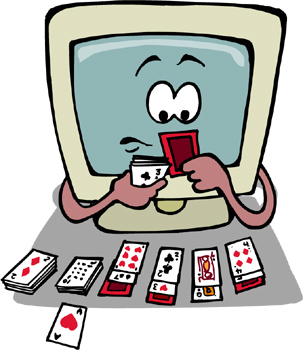How to Play Solitaire
Solitaire is an excellent source of entertainment for any down time that you have alone. Solitaire is also a fundamental card game for beginning card players in that it teaches players to be quite familiar with the suits and numbers in a standard deck of cards. However, solitaire is also versatile in that it can be played at any age or level with minimum skill.
Rules of Solitaire
The primary rules of solitaire require that you use a standard 52-card deck in order to play. Shuffle the cards and prepare to set up the primary board.
- Begin setting up for solitaire by placing one card face up on the right hand side of your card table or board.
- Place six face down cards individually to the left of your face-up card.
- Put a card face-up and slightly lowered on top of the face-down card directly to the left of your first face-up card.
- Distribute five cards face down directly on top of the remaining face down cards.
- Repeat the last two steps until you have placed a card face-up slightly lowered on top of the left-most face-down card.
Your final board should contain stacks of a total of 1, 2, 3, 4, 5, 6 and 7 cards respectively (this includes the face-up card on each pile). Leave room on the top right hand corner of your board for ace piles later in the game. Set your remaining cards face down in a stack in front of you as draw cards.
How to Play Solitaire
On your primary board, the cards of the highest value are the kings. Your first goal is to create tiered stacks of face-up cards that both descend in value and alternate suit colors (individual suits do not count in this stage). For example, if you have a king of hearts (red suit) on the board, you can put a queen of clubs (black suit) or spades (black suit) slightly lowered on top of the king, a jack of hearts (red suit) or diamonds (red suit) slightly lowered on top of that and so on.

How to Play Solitaire
Only face up cards can be moved from stack to stack during play to create the tiered descending face-up piles. Also, only kings may move and preoccupy an empty space on the board. Each time you remove a face-up card from a pile on the primary board to another pile, make sure you flip the revealed face-down card on the original pile to face-up.
A player may deal himself the top card in a draw of three at any time during the game but usually only if he finds himself unable to work with any of the card combinations in the primary and secondary boards.
Objective of the Solitaire Card Game
The solitaire card game is a great way to pass time alone since it is usually a one-player activity. The point of solitaire is to get rid of all the cards on the primary board by creating four stacks of same-carded suits facing up from the aces on the bottom to the kings on the top during play. Since four aces of clubs, spades, hearts and diamonds are eventually placed face-up on the upper right hand corner of the board – above the main seven face-down card stacks – the player is constantly conscious of the goal and can place consecutive card values face-up in the upper right hand corner throughout the game.
Aces must be placed in the upper right hand corner first and any other cards stacked on top of the aces must correspond to the respective suits of the aces and must be consecutive. One mistake players often make when playing solitaire is that they place cards too quickly on the face-up stacks of aces on the upper right hand side of the board too early on in the game and this makes it difficult to move layers of face-up cards around on the primary board because too many useful cards are missing.
You have the opportunity to put certain cards back onto the primary board of play under limited circumstances. You may only retrieve cards from the ace stacks on the upper right hand corner if they are currently visible. For example, if you want to bring a three of hearts back into play from the ace of hearts stack at upper right hand corner, but you have already stacked up to the seven of hearts (and thus the seven of hearts is the only card visible), you cannot bring back the three of hearts unless you bring back the seven, six, five and four of hearts into the game in that order. Bottom line: be careful and attentive when stacking cards in the same-suited final stacks too early in the game.
Why Play Solitaire
If you are not that familiar with a deck of cards, the solitaire card game is great because, as an individual game, it allows you to play and get familiar with the suits and numbers of a standard 52-card deck. Solitaire requires little pressure and can be played alone if you find yourself in a situation where you have no one with whom to play cards. It also requires little to no mathematics and is a great way to introduce young people to popular card-playing and teach them the order of card values.
